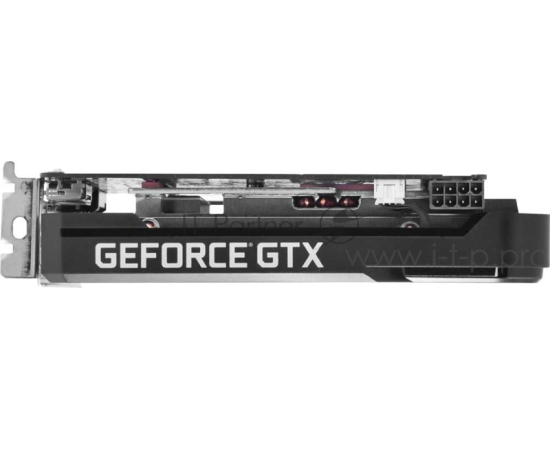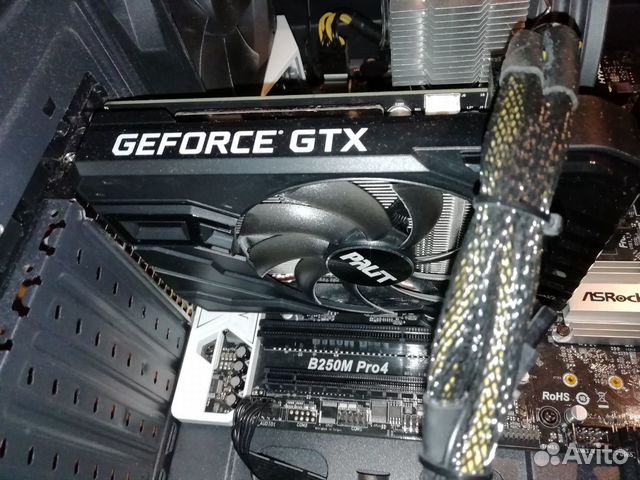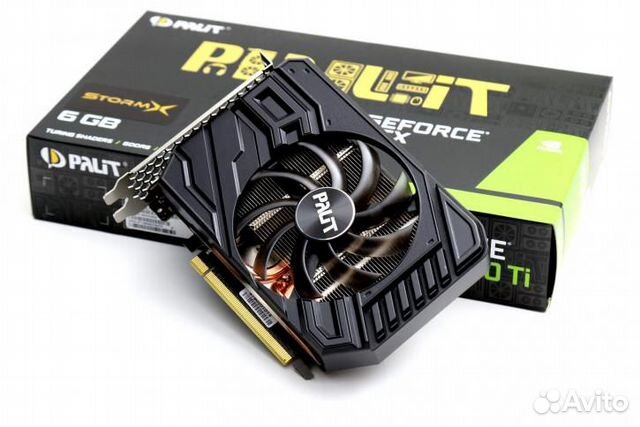Nvidia GeForce GTX 1660 Ti Review feat. Palit StormX
For PC gamers dismayed at the seemingly ever increasing cost of their hobby, Nvidia’s RTX family of graphics cards has been a huge disappointment. With costs of equivalent-tier parts rising yet again this generation – to the point where the flagship GeForce part, the RTX 2080 Ti, came in at £1,100 – the masses have by and large been left out. Even for those lucky enough to be able to afford the buy-in, much of the cost of entry has undoubtedly been funding specialised cores inherited from the workstation space and dedicated to advanced rendering techniques (real-time ray tracing and DLSS) that few games have managed to utilise, even now.
The GTX 1660 Ti is the start of Nvidia’s answer to the cries of crestfallen PC gamers that aren’t interested in paying for hardware that can only be fully leveraged in a handful of titles, and would instead prefer a GPU that is faster all-round and has more usable features as well as a more realistic price tag – you know, the way upgrades used to work.
Astonishingly, this is Nvidia’s first new GPU launch for the sub-£300 market in over two and a half years (excluding GT parts and refreshes), with the original GTX 1060 6GB having launched in July 2016. AMD, meanwhile, has struggled to capitalise on this absence of green, content instead with simply hitting F5, and has only released refreshed Polaris (RX 580/RX 570) and, well, re-refreshed Polaris cards with RX 590. It’s been a thoroughly unexciting time, hasn’t it?
To be clear, then, GTX 1660 Ti uses a brand new GPU built using Turing CUDA cores but without any RT Cores (used for ray tracing) or Tensor Cores (used for AI processing and DLSS). Both of the latter are necessary for Nvidia’s ‘Hybrid Rendering’ technique (measured by the made up “RTX-OPS” unit) that games like Battlefield V and Metro Exodus are just now starting to realise, and they are also responsible for the RTX naming. Without these cores, then, we’re back to familiar GTX territory (and TFLOPs – remember those?!), though as to where the ‘16’ came from, your guess is as good as ours – answers on a postcard in the comments, please.
GTX 1660 Ti is also a clear admission that the full Turing architecture seen thus far doesn’t scale downwards as far as Nvidia might like, and just as clear a confirmation that Hybrid Rendering isn’t ready for mass adoption. The RT and Tensor Cores apparently require a certain level of traditional GPU horsepower to be effective in games. Evidently, that level is one Nvidia feels unable to reach at the sub-$300 price point, and it has thus decided to invest in designing and building a GPU that excludes them instead. Although official confirmation of other parts is non-existent, we fully expect this approach to be scaled downwards, since anything coming in below GTX 1660 Ti also won’t meet the performance threshold to make RT and Tensor cores “worth it”. Similarly, we expect the GTX 1660 Ti to be the Turing GTX flagship, since scaling this method upwards is highly likely to eat into RTX sales and confuse consumers even more.
Time for a shiny new spec table, don’t you think?
| Nvidia GeForce RTX 2080 Ti | Nvidia GeForce RTX 2080 | Nvidia GeForce RTX 2070 | Nvidia GeForce RTX 2060 | Nvidia GeForce GTX 1660 Ti | Nvidia GeForce GTX 1060 6GB | |
| Architecture | Turing (RTX) | Turing (RTX) | Turing (RTX) | Turing (RTX) | Turing (GTX) | Pascal |
| Codename | TU102 | TU104 | TU106 | TU106 | TU116 | GP106 |
| Base Clock | 1,350MHz | 1,515MHz | 1,410MHz | 1,365MHz | 1,500MHz | 1,506MHz |
| Boost Clock | 1,545MHz | 1,710MHz | 1,620MHz | 1,620MHz | 1,770MHz | 1,708MHz |
| Layout | 6 GPCs, 68 SMs | 6 GPCs, 46 SMs | 3 GPCs, 36 SMs | 3 GPCs, 30 SMs | 3 GPCs, 24 SMs | 2 GPCs, 10 SMMs |
| CUDA Cores | 4,352 | 2,944 | 2,304 | 1,920 | 1,536 | 1,280 |
| Tensor Cores | 544 | 368 | 288 | 240 | N/A | N/A |
| RT Cores | 68 | 46 | 36 | 30 | N/A | N/A |
| Texture Units | 272 | 184 | 144 | 120 | 96 | 80 |
| ROPs | 88 | 64 | 64 | 48 | 48 | 48 |
| L2 Cache | 6MB | 4MB | 4MB | 3MB | 1. 5MB 5MB |
1.5MB |
| Peak TFLOPS (FP32) | 13.4 | 10 | 7.5 | 6.2 | 5.5 | 4.4 |
| Transistors | 18.6 billion | 13.6 billion | 10.8 billion | 10.8 billion | 6.6 billion | 4.4 billion |
| Die Size | 754mm2 | 545mm2 | 445mm2 | 445mm2 | 284mm2 | 200mm2 |
| Process | 12nm FFN | 12nm FFN | 12nm FFN | 12nm FFN | 12nm FFN | 16nm |
| Memory | 11GB GDDR6 | 8GB GDDR6 | 8GB GDDR6 | 6GB GDDR6 | 6GB GDDR6 | 6GB GDDR5 |
| Memory Data Rate | 14Gbps | 14Gbps | 14Gbps | 14Gbps | 12Gbps | 8Gbps effective |
| Memory Interface | 352-bit | 256-bit | 256-bit | 192-bit | 192-bit | 192-bit |
| Memory Bandwidth | 616GB/s | 448GB/s | 448GB/s | 336GB/s | 288GB/s | 192GB/sec |
| TDP | 250W | 215W | 175W | 160W | 120W | 120W |
TU116 is a newly manufactured GPU built on the same 12nm FinFET process as other Turing cards. It comes fully enabled in GTX 1660 Ti and brings Turing down to its smallest die size yet.
It comes fully enabled in GTX 1660 Ti and brings Turing down to its smallest die size yet.
At a high level the structure of the new GPU remains the same as other Turing parts, with Graphics Processing Clusters (GPCs) subdivided into Texture Processing Clusters (TPCs, four per GPC here) and each TPC housing two TU116 Streaming Multiprocessors, or SMs. We discuss the Turing architecture in detail here, and it’s worth a read if you want to fully understand the less detailed overview below.
At the SM level is where things look different, and we believe this is the first time Nvidia has produced two physically different SMs for the same architecture. This is a pretty big deal in itself given the obvious cost overheads of designing, engineering, and validating another semi-new SM design, but Nvidia obviously believes it to be worth it instead of the alternative i.e. dedicating silicon to cores that would be functionally useless on lower-end Turing parts.
First up, the RT Core is gone entirely from the new SM, and this simply means no real-time ray tracing support in the few games that support or are set to support it – no big loss at this price level.
Next, the Tensor Cores also get the chop, although it’s more accurate to say they’ve been stripped back. Tensor Cores accelerate complex matrix-based FP16 math, and this functionality is now removed, so Nvidia’s DLSS technique is a no-go. However, simpler FP16 operations are used in games for low-precision effects (Nvidia gives Far Cry 5’s water simulation as an example), and RTX Turing parts rely on FP16 units embedded in the Tensor Cores to process these at twice the normal FP32 throughput. All 128 of these FP16 units remain, and thus so does the doubled FP16 throughput.
Beyond those two differences, the SM remains the same. The concurrent floating point (FP32) and integer (INT32) pathways are maintained with 64 FP32 cores matched by 64 INT32 cores per SM, allowing parallel execution of different instruction types instead of one after the other as with Pascal GPUs. The same four Texture Units are present, and the new unified architecture for shared memory, L1, and texture caching is also retained, with a 96KB pool available for each SM.
It’s also worth noting that the TU116 GPU supports Nvidia’s new variable rate shading techniques, where certain parts of a scene can have their pixel shading rate reduced without a reduction in perceived quality.
The concurrent integer pathway, reworked SM cache, and variable rate shading are the three big factors in Turing being faster than Pascal in traditional gaming workloads. It’s also why Nvidia’s own figure suggests ‘up to 1.5x’ uplift for the new part over GTX 1060 despite only a 20 percent increase in CUDA Cores and very similar clock speeds. That said, all three factors are workload-dependent variables rather than raw throughput gains, so exact performance differences between GTX 1060 and GTX 1160 Ti will vary depending on how well a game can leverage the new architecture and shading techniques.
When Turing launched, Nvidia boasted about its larger, faster L2 cache. For every 32-bit memory controller and eight ROPs, Turing RTX cards have 512KB of L2 cache, but for GTX 1660 Ti, we’re back to Pascal levels of 256KB per controller/ROP slice for a total of 1. 5MB – the same as GTX 1060. We are unclear what the reasoning is here, and Nvidia also hasn’t revealed whether the L2 cache here is faster compared to Pascal or not, only stating that it is ‘closer in config’ to GTX 1060’s L2 cache, but L2 cache is certainly costly in terms of die size, and Nvidia reckons this wasn’t worth the potential performance uplift/power savings for the target market.
5MB – the same as GTX 1060. We are unclear what the reasoning is here, and Nvidia also hasn’t revealed whether the L2 cache here is faster compared to Pascal or not, only stating that it is ‘closer in config’ to GTX 1060’s L2 cache, but L2 cache is certainly costly in terms of die size, and Nvidia reckons this wasn’t worth the potential performance uplift/power savings for the target market.
The ROP count of 48 is the same as both GTX 1060 and RTX 2060 and so is the 192-bit memory interface. A move from GDDR5 in GTX 1060 (or GDDR5X in the refresh) to GDDR6 sees the memory clock speed go up by 50 percent, delivering an equivalent increase in memory bandwidth. This is the first Turing card we’ve seen to use slower 12Gbps GDDR6 as opposed to the 14Gbps GDDR6 used thus far, though. Again, the reasoning is to do with keeping costs down and not really “needing” the extra bandwidth of 14Gbps. It also leaves more room for a faster memory refresh further down the line, especially as the memory controllers are the same as those in RTX parts.
The GTX 1660 Ti inherits the latest Nvidia encoder (NVENC) and decoder (NVDEC) units, bringing about the various benefits outlined here.
Power savings associated with the 12nm process, GDDR6, and the more efficient core/cache structure allow Nvidia to hit the same TDP as GTX 1060 of 120W in spite of the predicted performance gains.
GTX 1660 Ti is hard launch with stock expected immediately in the usual places. There is no reference or Founders Edition design, although Nvidia says it does require an eight-pin PCIe power connection. Board partners can also pick between different combinations of DVI, DisplayPort 1.4a, HDMI 2.0b, and even USB-C VirtualLink, as all are supported. G-Sync and VESA Adaptive Sync (i.e. FreeSync) are also supported over the DisplayPort connection. SLI, however, is not supported.
As the card that outright replaces the GTX 1060 6GB in Nvidia’s lineup, the GTX 1660 Ti is said to provide up to 1.5x the performance of the outgoing part and approximately 3x the performance of a GTX 960, which Nvidia says almost two thirds of its own install base is still using. It’s also banking on this being the go-to card for competitive gamers looking for a 120fps+ 1080p experience in popular multiplayer titles.
It’s also banking on this being the go-to card for competitive gamers looking for a 120fps+ 1080p experience in popular multiplayer titles.
Let’s take a quick look at the Palit StormX implementation of GTX 1660 Ti before heading into the performance results.
1 — Nvidia GeForce GTX 1660 Ti Review2 — Palit GTX 1660 Ti StormX Analysis3 — Test Setup4 — 3DMark and VRMark5 — Battlefield 16 — Deus Ex: Mankind Divided7 — Middle-Earth: Shadow of War8 — Total War: Warhammer II9 — Wolfenstein II: The New Colossus10 — World of Tanks Encore11 — Power and Thermals12 — Overclocking13 — Performance Analysis14 — Conclusion
Review: Palit GeForce GTX 1660 Ti StormX — Graphics
Nvidia is on a mission to improve PC graphics by encouraging the industry to adopt technologies such as ray tracing and machine-learning-based image enhancement. To this end, the GeForce RTX series of cards has dedicated hardware — RT and Tensor cores — to accelerate the computationally-heavy work involved in producing more realistic-looking images. Available in RTX 2080 Ti, 2080, 2070, and 2060 forms, each model combines these features with an all-new architecture known as Turing.
Available in RTX 2080 Ti, 2080, 2070, and 2060 forms, each model combines these features with an all-new architecture known as Turing.
It’s fair to say that GeForce RTX has got off to a stumbling start, one certainly not helped by a significant delay in games engines using Nvidia’s technology. Yet there is cause for optimism in the green camp as a few parts of the jigsaw fall into place, including the clearing of older 10-series GPUs from the channel, games launching with RTX-specific technology in tow, and rival AMD limited in what it can put forward as a credible high-end rival.
Nvidia does still face a problem or two. The first, ironically, is the RTX 2060, which though a thoroughly decent performer at the £315-£370 price point, is painfully expensive to produce. Why? Because it uses the same massive die — 10.8bn transistors, 445mm² — as the RTX 2070. The GPU’s innate horsepower also happens to be barely enough to drive solid performance in titles that do take advantage of its reduced-capacity RT and Tensor tech.
What Nvidia really needs is a specific, custom Turing die, much smaller and power-efficient in size and power, explicitly designed for the premium-mainstream market. One that is bereft of those space-taking RT and Tensor cores. Such a GPU ought to play nicely in the £250 price point, you would think.
As it happens, such a GPU is formally unveiled today. Enter the GeForce GTX 1660 Ti.
GeForce: from GTX to RTX to GTX |
|||||||||
|---|---|---|---|---|---|---|---|---|---|
|
RTX 2080 Ti |
GTX 1080 Ti |
RTX 2080 |
GTX 1080 |
RTX 2070 |
GTX 1070 |
RTX 2060 |
GTX 1660 Ti |
GTX 1060 |
|
| Launch date |
Sep 2018 |
Mar 2017 |
Sep 2018 |
May 2016 |
Oct 2018 |
May 2016 |
Jan 2019 |
Feb 2019 |
May 2016 |
| Codename |
TU102 |
GP102 |
TU104 |
GP104 |
TU106 |
GP104 |
TU106 |
TU116 |
GP106 |
| Architecture |
Turing |
Pascal |
Turing |
Pascal |
Turing |
Pascal |
Turing |
Turing |
Pascal |
| Process (nm) |
12 |
16 |
12 |
16 |
12 |
16 |
12 |
12 |
16 |
| Transistors (bn) |
18. |
12 |
13.6 |
7.2 |
10.8 |
7.2 |
10.8 |
6.6 |
4.4 |
| Die Size (mm²) |
754 |
471 |
545 |
314 |
445 |
314 |
445 |
284 |
200 |
| Base Clock (MHz) |
1,350 |
1,480 |
1,515 |
1,607 |
1,410 |
1,506 |
1,365 |
1,500 |
1,506 |
| Boost Clock (MHz) |
1,545 |
1,582 |
1,710 |
1,733 |
1,620 |
1,683 |
1,680 |
1,770 |
1,708 |
| Founders Edition Clock (MHz) |
1,635 |
— |
1,800 |
— |
1,710 |
— |
1,680 |
— |
1,708 |
| Shaders |
4,352 |
3,584 |
2,944 |
2,560 |
2,304 |
1,920 |
1,920 |
1,536 |
1,280 |
| GFLOPS |
13,448 |
11,340 |
10,068 |
8,873 |
7,465 |
6,463 |
6,221 |
5,437 |
3,855 |
| Founders Edition GFLOPS |
14,231 |
— |
10,598 |
— |
7,880 |
— |
6,221 |
— |
3,855 |
| Tensor Cores |
544 |
— |
368 |
— |
288 |
— |
240 |
— |
— |
| RT Cores |
68 |
— |
46 |
— |
36 |
— |
30 |
— |
— |
| Memory Size |
11GB |
11GB |
8GB |
8GB |
8GB |
8GB |
6GB |
6GB |
6GB |
| Memory Bus |
352-bit |
352-bit |
256-bit |
256-bit |
256-bit |
256-bit |
192-bit |
192-bit |
192-bit |
| Memory Type |
GDDR6 |
GDDR5X |
GDDR6 |
GDDR5X |
GDDR6 |
GDDR5 |
GDDR6 |
GDDR6 |
GDDR5 |
| Memory Clock |
14Gbps |
11Gbps |
14Gbps |
10Gbps |
14Gbps |
8Gbps |
14Gbps |
12Gbps |
8Gbps |
| Memory Bandwidth |
616 |
484 |
448 |
320 |
448 |
256 |
336 |
288 |
192 |
| ROPs |
88 |
88 |
64 |
64 |
64 |
64 |
48 |
48 |
48 |
| Texture Units |
272 |
224 |
184 |
160 |
144 |
120 |
120 |
96 |
80 |
| L2 cache (KB) |
5,632 |
2,816 |
4,096 |
2,048 |
4,096 |
2,048 |
3,072 |
1,536 |
1,536 |
| Power Connector |
8-pin + 8-pin |
8-pin + 6-pin |
8-pin + 6-pin |
8-pin |
8-pin |
8-pin |
8-pin |
8-pin |
6-pin |
| TDP (watts) |
250 |
250 |
215 |
180 |
175 |
150 |
160 |
120 |
120 |
| Founders Edition TDP (watts) |
260 |
— |
225 |
— |
185 |
— |
160 |
— |
— |
| Suggested MSRP |
$999 |
$699 |
$699 |
$549 |
$499 |
$379 |
$349 |
$279 |
$249 |
| Founders Edition MSRP |
$1,199 |
$699 |
$799 |
$699 |
$599 |
$449 |
$349 |
— |
$299 |
What’s in a Name?
Let’s get the confusing bit out of the way first: the GPU’s name. Nvidia believes it is the logical successor to mainstream champs of yore. GTX 1060 and GTX 960 sold in droves, so it would normally have made sense to call this the GeForce GTX 2060. The rather large problem is that RTX 2060 exists, therefore having both RTX 2060 and GTX 2060 coexist, offering different feature-sets, is a marketeer’s nightmare. Nvidia could have got away with, say, GTX 2050, but the thinking is that 20-series GPUs need to have aforementioned forward-looking tech intact.
Nvidia believes it is the logical successor to mainstream champs of yore. GTX 1060 and GTX 960 sold in droves, so it would normally have made sense to call this the GeForce GTX 2060. The rather large problem is that RTX 2060 exists, therefore having both RTX 2060 and GTX 2060 coexist, offering different feature-sets, is a marketeer’s nightmare. Nvidia could have got away with, say, GTX 2050, but the thinking is that 20-series GPUs need to have aforementioned forward-looking tech intact.
That’s the rationale behind the unusual naming scheme, and though we don’t like it per se, there’s not much else Nvidia can do with the current stack the way it is. The Ti suffix, meanwhile, ensures that a cheaper, non-Ti card is around the corner.
Architecture Composition
The full-fat TU116 die; much smaller than the RTX blueprint
The TU116 block diagram sheds light on the GeForce GTX 1660 Ti’s architecture provenance. Composed of three GPCs each holding 8 SMs, which in turn hold 64 single-precision Cuda cores, there’s 1,536 shaders on tap. Each SM also holds four texture-units (96 in sum). On the back end reside 48 ROPs connected to a 192-bit (6 x 32-bit) memory controller interfacing with GDDR6 memory. The design is what we’d expect from a $250-ish card for 2019.
Each SM also holds four texture-units (96 in sum). On the back end reside 48 ROPs connected to a 192-bit (6 x 32-bit) memory controller interfacing with GDDR6 memory. The design is what we’d expect from a $250-ish card for 2019.
It’s key to understand that Nvidia has fundamentally redesigned each SM for this class of GPU, compared to the enthusiast RTX models, which is a first as far as we can tell. Remember that each RTX’s SM has baked-in RT and Tensor cores. These are removed this time around — not just dormant — and it is one reason why the RTX 2060 is a whopping 57 per cent bigger than GTX 1660 Ti. In order to save more space and power, Nvidia also chops the buffering L2 cache in half — 1,536KB vs. 3,072KB — believing that streamlining the architecture reduces the need for space-hogging cache.
Even so, the TU116 feels a bit big given its 12nm process. 2016’s GeForce GTX 1070 based on older Pascal technology is not much larger and ought to benchmark at least as well as GTX 1660 Ti. The machinations of silicon, eh.
The machinations of silicon, eh.
Speeds and Feeds
Keeping to a leaner design enables Nvidia to increase the base and boost frequencies to 1,500MHz and 1,770MHz, respectively, helping ameliorate the shader deficit to RTX 2060. Still, GTX 1660 Ti faces a 12.6 per cent FP32 TFLOPS shortfall. Meanwhile, though GTX 1660 Ti has the same 6GB framebuffer and 192-bit interface, memory speed drops from 14Gbps to 12Gbps.
The upshot, in pure rasterisation terms, is that GTX 1660 Ti ought to benchmark at around 85 per cent of the RTX 2060’s levels. Is that enough to justify the $279 (£259) price point attributed to the cheapest partner cards, especially given that they don’t feature the much-publicised RT or Tensor tech? That’s a tricky one. We’d really like to see the GTX 1660 Ti come in at $249, properly differentiating GTX and RTX.
Nvidia is keener, of course, to extol the virtues of GTX 1660 Ti vs. Pascal-based GTX 1060 and, looking further back, GTX 960. Compared to its 10-series cousin, the new GPU is significantly more powerful from a pure specification viewpoint. That only tells half the story, mind, as the Turing architecture, clock for clock, offers further meaty speed-ups thanks to concurrent integer and floating-point execution, an improved cache and shared-memory setup, and an extra 50 per cent memory bandwidth. So it should, as the wildly popular GTX 1060 is nearing its third birthday.
Compared to its 10-series cousin, the new GPU is significantly more powerful from a pure specification viewpoint. That only tells half the story, mind, as the Turing architecture, clock for clock, offers further meaty speed-ups thanks to concurrent integer and floating-point execution, an improved cache and shared-memory setup, and an extra 50 per cent memory bandwidth. So it should, as the wildly popular GTX 1060 is nearing its third birthday.
The sum of these changes benefits games on a case-by-case basis — some prefer concurrent INT and FP execution (Shadow of the Tomb Raider), others are more agreeable to the unified cache (COD: BLOPS 4). Nvidia says these architecture improvements make more sense for how modern games engines have evolved, citing a widening performance gap between GTX 1060 and GTX 1660 Ti as time goes on.
Given its positioning, GeForce GTX 1660 Ti escapes the usual Founders Edition treatment, sadly, so it’s up to partners to come up with their own designs on the 120W TDP GPU. Segueing nicely, let’s take a look at such a partner card.
Segueing nicely, let’s take a look at such a partner card.
Testing the GeForce GTX 1660 Ti video card in 11 games
The GeForce GTX 1660 Ti video card has recently been released, and this article will be tested in detail in games and compared with its closest analogues. The new GeForce GTX 1660 Ti comes with 6 GB of GDDR6 memory clocked at 1500 MHz and a data rate of 12 Gbps. Using a 192-bit memory bus, this gives a peak throughput of 288.1 GB/s, which is 14% lower than the RTX 2060, but 13% higher than the GTX 1070 and 50% more than the GTX 1060.
All testing of the GeForce GTX 1660 Ti was done on a 5GHz Intel Core i9-9900K testbed with 32GB DDR4-3200 RAM. Adrenalin 2019 Edition 19.2.2 drivers used for AMD Radeon video cards and Game Ready 418.91 WHQL for NVIDIA GeForce video cards. All games are tested at maximum graphics settings.
Shadow of the Tomb Raider
The GTX 1660 Ti looks impressive in Shadow of the Tomb Raider, on par with the GTX 1070 Ti at 87 fps.
Forza Horizon 4
In Forza Horizon 4, the GTX 1660 Ti came very close to the RTX 2060 and GTX 1070 and was only 5% weaker than them.
Resident Evil 2
The GTX 1660 Ti delivered an impressive 108 FPS in Resident Evil 2, placing it between the GTX 1070 and GTX 1070 Ti.
Fortnite
The GTX 1660 Ti is sure to be a popular choice among Fortnite players as it’s the cheapest way to get over 100fps on max settings.
Metro Exodus
Metro Exodus 1660 Ti matches 1070 and is 30% faster than GTX 1060. Siege is well ahead of both it and the GTX 1080.
Battlefield V
GTX 1660 Ti with 90 FPS in Battlefield V is just behind the GTX 1070, but by a wide margin from the GTX 1060.
World of Tanks
Interestingly, the GTX The 1660 Ti couldn’t catch up with the GTX 1070 in World of Tanks and performed 7% worse.
Apex Legends
In the new popular battle royale, the GTX 1660 TI achieved 123 FPS, 1 frame less than the GTX 1070 Ti and 16% slower than the RTX 2060.
Apex Legends
In the new popular battle royale GTX 166 TI achieved 123 FPS, 1 frame less than the GTX 1070 Ti and 16% slower than the RTX 2060. GTX 1070 Ti and 16% slower than RTX 2060.
Power Consumption and Temperatures
The GTX 1660 Ti has increased its total power consumption to just 271W, making it very efficient. Basically, you get the GTX 1070 – similar performance and 8% system-wide power savings.
In terms of operating temperatures, the MSI GTX 1660 Ti Gaming X graphics card we tested was very quiet even after an hour of stress. The fans were spinning at speeds up to 1500 rpm, which gave the video card a peak temperature of 66 degrees at a room temperature of 21 degrees.
Overclocked
Even when overclocked, the 1660 Ti maintains the same operating temperature and fan speed while running only one degree warmer. The operating frequency increased by only 4% on average. We were able to massively overclock the memory speed from 12Gb/s to 15Gb/s.

 6
6